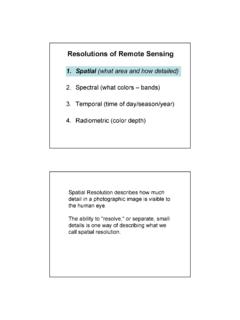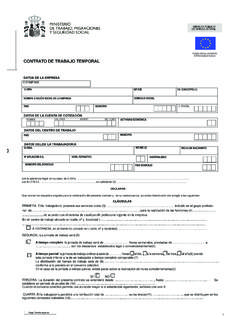Transcription of Temporal Features in SQL standard
1 WG2 N1536. WG3: KOA-046. Temporal Features in SQL standard Krishna Kulkarni, IBM Corporation May 13, 2011. 1. Agenda Brief description of the SQL standard List of Features in the latest version Application-time period tables System-versioned tables System-versioned application-time period tables Q&A. 2. Brief description of the SQL standard ISO/IEC 9075, Database Language SQL is the dominant database language de-jure standard . First published in 1987. Revised versions published in 1989, 1992, 1999, 2003, and 2008. A new version of SQL expected in late 2011; likely to progress to FDIS stage after the current meetings. Multi-part standard 9 Parts: 1, 2, 3, 4, 9, 10, 11, 13, and 14; Parts 3, 9, 10, and 13 are currently inactive.
2 Large number of commercial implementations, multi- billion dollar industry. Large number of applications written using SQL. 3. Brief description of the SQL standard (contd.). Divided into 9 parts: Part 1 Framework (SQL/Framework). Part 2 Foundation (SQL/Foundation). Part 3 Call-Level Interface (SQL/CLI). Part 4 Persistent Stored Modules (SQL/PSM). Part 9 Management of External Data (SQL/MED). Part 10 Object Language Bindings (SQL/OLB). Part 11 Information and Definition Schemas (SQL/Schemata). Part 13 SQL Routines and Types using the Java Programming Language (SQL/JRT. Part 14 XML-Related Specifications (SQL/XML). 4. Brief description of the SQL standard (contd.))
3 Part 2 SQL/Foundation: Largest and the most important part SQL. General-purpose programming constructs - Data types, expressions, predicates, etc. Data Definition: CREATE/ALTER/DROP of tables, views, constraints, triggers, stored procedures, stored functions, etc. Query constructs: SELECT, joins, etc. Data Manipulation: INSERT, UPDATE, MERGE, DELETE, etc. Access Control: GRANT, REVOKE etc. Transaction Control: COMMIT, ROLLBACK, etc. Connection Management: CONNECT, DISCONNECT, etc. Session Management: SET SESSION statements. Exception Handling: GET DIAGNOSTICS statement 5. Brief description of the SQL standard (contd.)
4 For conformance purpose, SQL is divided into a list of Features , grouped under two categories: Mandatory Features Optional Features To claim conformance, an implementation must conform to all mandatory Features . An implementation may conform to any number of optional Features . Both are listed in Annex F of each part of the SQL. standard . SQL/Foundation:2008 specifies 164 mandatory Features and 280 optional Features . 6. Agenda Brief description of the SQL standard List of Features in the latest version Application-time period tables System-versioned tables System-versioned application-time period tables Q&A. 7. List of Features in the latest version New version of SQL standard has completed the FCD.
5 Ballot; expected to progress FDIS ballot in a couple of months. A total 34 new Features have been added to SQL/Foundation all in the optional category. This brings the list of optional Features in SQL/Foundation to 314: F054 TIMESTAMP in DATE type precedence list F202 TRUNCATE TABLE: identity column restart option F314 MERGE Statement with DELETE branch F383 Set column not null clause F384 Drop identity property clause 8. List of Features in the latest version (contd.). F385 Drop column generation expression clause F386 Set identity column generation clause F492 Optional table constraint enforcement F860 Dynamic <fetch row count> in <fetch first clause>.
6 F861 Top-level <result offset clause> in <query expression>. F862 <result offset clause> in subqueries F863 Nested <result offset clause> in <query expression>. F864 Top-level <result offset clause> in views F865 Dynamic <offset row count> in <result offset clause>. F866 FETCH FIRST clause: PERCENT option F867 FETCH FIRST clause: WITH TIES option 9. List of Features in the latest version (contd.). S401 Distinct types based on array types S402 Distinct types based on distinct types S403 ARRAY_MAX_CARDINALITY. S404 TRIM_ARRAY. T177 Sequence generator support: simple restart option T178 Identity columns: simple restart option T180 System-versioned tables T181 Application-time period tables T495 Combined data change and retrieval T521 Named arguments in CALL statement T522 Default values for IN parameters of SQL-invoked procedures 10.
7 List of Features in the latest version (contd.). T614 NTILE function T615 LEAD and LAG functions T616 NULL treatment option for LEAD and LAG functions T617 FIRST_VALUE and LAST_VALUE functions T618 NTH_VALUE function T619 Nested window functions T620 WINDOW clause: GROUPS option 11. Agenda Brief description of the SQL standard List of Features in the latest version Application-time period tables System-versioned tables System-versioned application-time period tables Q&A. 12. feature T181 Application-time period tables Application-time period tables are tables that contain a PERIOD clause (newly-introduced) with an user-defined period name.
8 Currently restricted to Temporal periods only; may be relaxed in the future. Application-time period tables must contain two additional columns, one to store the start time of a period associated with the row and one to store the end time of the period. Values of both start and end columns are set by the users. Additional syntax is provided for users to specify primary key/unique constraints that ensure no two rows with the same key value have overlapping periods. 13. feature T181 Application-time period tables (contd.). Additional syntax is provided for users to specify referential constraints that ensure the period of every child row is completely contained in the period of exactly one parent row or in the combined period of two or more consecutive parent rows.
9 Queries, inserts, updates and deletes on application-time period tables behave exactly like queries, inserts, updates and deletes on regular tables. Additional syntax is provided on UPDATE and DELETE. statements for partial period updates and deletes. 14. Creating an application-time period table CREATE TABLE employees (emp_name VARCHAR(50) NOT NULL PRIMARY KEY, dept_id VARCHAR(10), start_date DATE NOT NULL, end_date DATE NOT NULL, PERIOD FOR emp_period (start_date, end_date), PRIMARY KEY (emp_name, emp_period WITHOUT OVERLAPS), FOREIGN KEY (dept_id, PERIOD emp_period) REFERENCES. departments (dept_id, PERIOD dept_period)).
10 Notes: PERIOD clause automatically enforces the constraint (end_date > start_date). The name of the period can be any user-defined name. The period is considered to start on the start_date value and end on the value just prior to end_date value. This corresponds to the (closed, open) model of periods. 15. Inserting rows into an application-time period table When a row is inserted into an application-time period table, user provides the start and end time of the period for each row. User-supplied time values can be either in the past, current, or in the future. 16. Inserting rows into an application-time period table (contd.)






